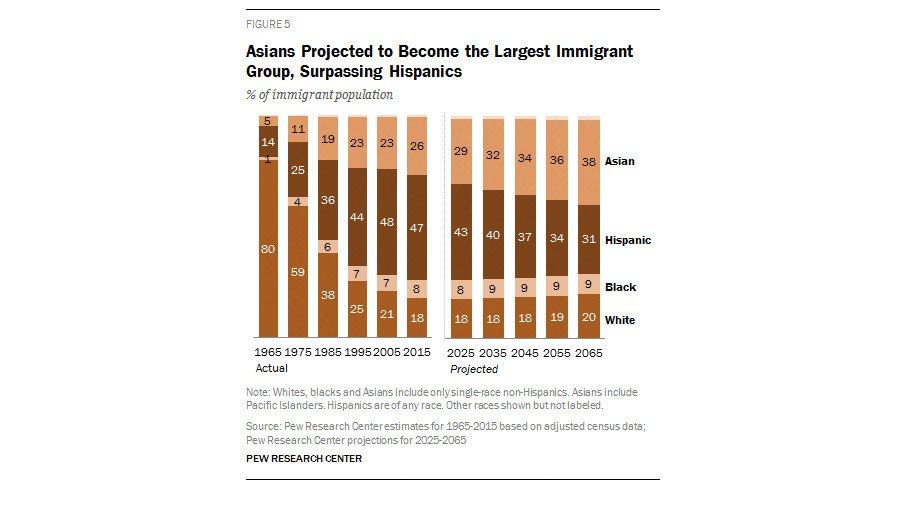Asians likely to surpass Hispanics as largest foreign-born group in US by 2065 - study

Asian immigrants are expected to surpass Hispanics to become the largest group of foreign-born people in America by 2065, according to estimates in a new groundbreaking study.
The composition of the US immigrant population will change dramatically, according to Pew Research projections.
In 2015, nearly half of immigrants (47 percent) residing in the US are Hispanic. But as immigration from Latin America, especially Mexico, has slowed down in recent years, the share of the foreign born who are Hispanic is expected to fall to 31 percent by 2065. Meanwhile, Asian immigrants are expected to make up 38 percent of the foreign-born population by 2065.
Part of the reason for the shift is that the fertility rate of women in Latin America, especially Mexico, has decreased. Pew's director of Hispanic research, Mark Hugo Lopez, said that in Mexico women are now having around two children, while in the 1960s and 1970s, they were having about seven children per woman on average.

"There are relatively fewer people who would choose to migrate from Mexico so demographic changes in Mexico have led to a somewhat smaller pool of potential migrants," he told AP. "At the same time we've seen a growing number of immigrants particularly from China or India who are coming for reasons such as pursuing a college degree or coming here to work temporarily in the high-tech sector."
Despite the projected increase in Asian immigrants, Hispanics will still make up a larger number, thanks to their children born in the US.
"Hispanic population growth is coming from people born here in the United States," Lopez said. "It is really US births that are now the driver of Hispanic population growth, and that's a recent change from what we saw in the '80s and '90s."

Immigrants presently make up 14 percent of the population, a significant increase from 5 percent in 1965. Pew Research projections also show that black immigrants and white immigrants together will become a slightly larger share of the nation’s immigrants by 2065 than in 2015 (29% vs. 26%).
If current demographic trends continue, future immigrants and their children is projected to become an even bigger source of population growth. Between 2015 and 2065, they are likely to account for up to 88 percent of the US population increase, or 103 million people, as the nation grows to 441 million, the new study shows.
READ MORE: Dissatisfaction with treatment of black population soars in just 2 years - Gallup
No racial or ethnic group will hold a majority in the United States by 2065, with whites holding 46 percent of the population, Hispanics at 24 percent, Asians at 14 percent and blacks at 13 percent. (as things stand now, the US is 62 percent white, 18 percent Hispanic, 12 percent black and 6 percent Asian.)
Pew also asked Americans surveyed to describe in one word immigrants currently living in the US. Twelve percent said "illegal," 5 percent – "overpopulation," 4 percent - "legality (other than illegal)," 3 percent came up with such variants as "jobs,"''deportation,"''Americans" and "work ethic." Forty-nine percent offered some general descriptions, 12 percent of those were positive, 11 percent negative and 26 percent neutral, according to the report.
The survey was conducted online from March 10 to April 6, 2015, the margin of sampling error is said to plus or minus 2.4 percentage points.












